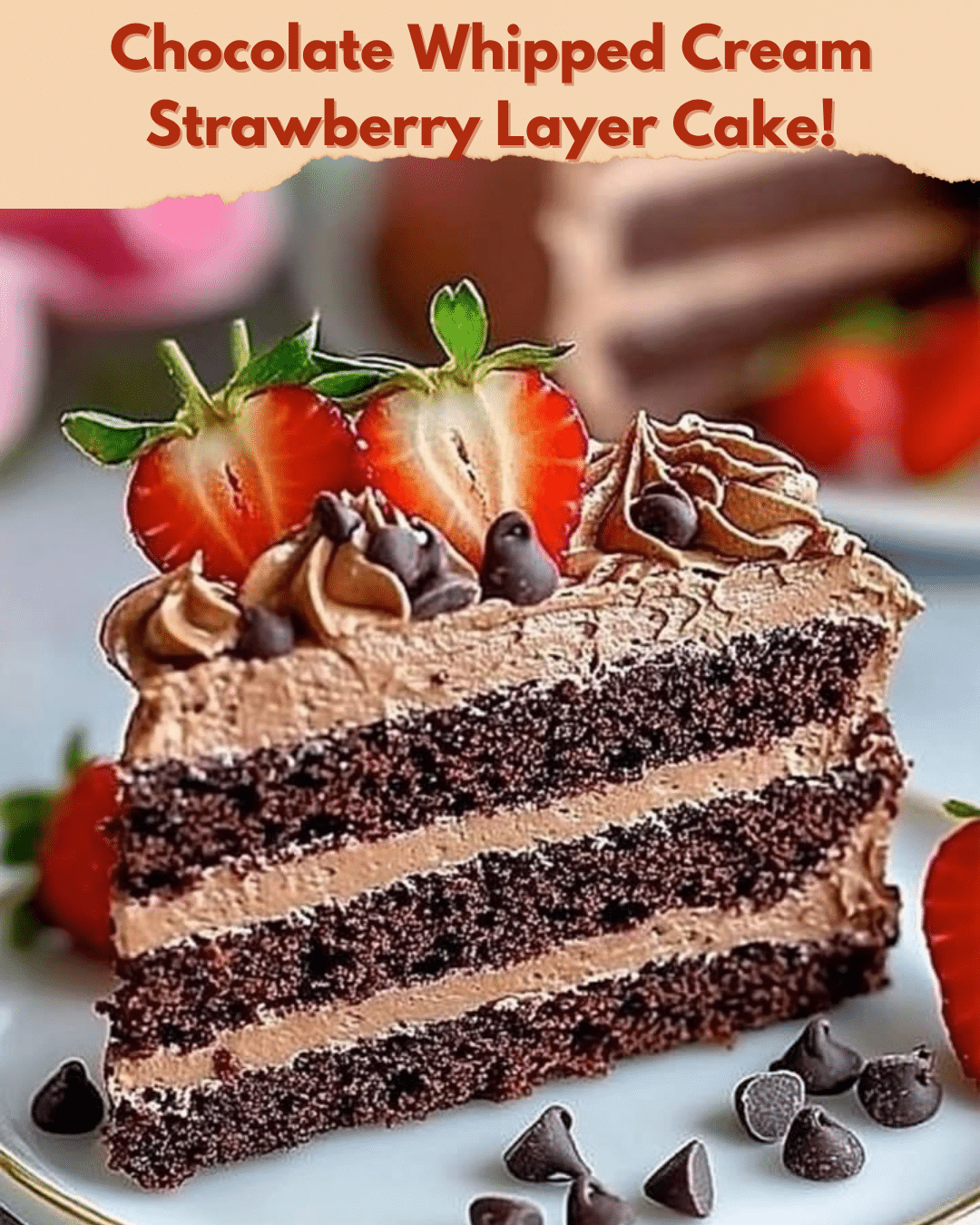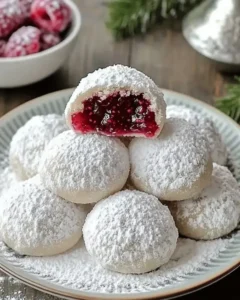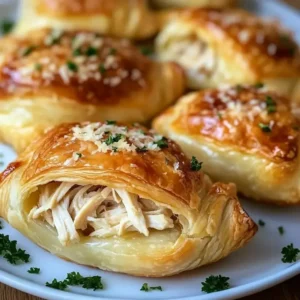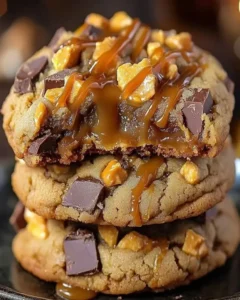Chocolate Whipped Cream Strawberry Layer Cake: A Dessert Delight
Indulge in the irresistible delight of a Chocolate Whipped Cream Strawberry Layer Cake. This decadent dessert combines layers of moist chocolate cake with fresh strawberries and luscious whipped cream. Perfect for special occasions or as an indulgent treat, this cake will satisfy any chocolate lover’s cravings while providing a fresh twist with vibrant strawberries. The combination of textures and flavors makes every bite a delight, creating a memorable dessert experience that’s worth savoring.
Quick Recipe Highlights
- Flavor Profile: A rich, chocolatey taste balanced with the freshness of ripe strawberries and the creamy sweetness of whipped cream.
- Texture: Soft, fluffy cake layers contrasted by the juicy strawberries and smooth whipped cream.
- Aroma: An enticing mix of cocoa and fresh strawberries fills the air as you prepare and serve this cake.
- Visual Appeal: The alternating layers of chocolate, white cream, and red strawberries create a striking and appetizing visual.
- Skill Level Needed: Requires basic baking skills such as layering and frosting, making it accessible for home bakers.
- Special Equipment: Mixing bowls, stand mixer or hand mixer, cake pans, and a spatula for assembly.
Recipe Overview
- Difficulty Level: This recipe is considered moderate due to the need for careful layering and proper timing in baking and cooling the cake layers.
- Category: The Chocolate Whipped Cream Strawberry Layer Cake falls under dessert recipes, especially for celebrations and gatherings.
- Cuisine: This dessert is rooted in classic American baking traditions, showcasing the popular chocolate and strawberry combination.
- Cost: Affordable with standard baking ingredients, fresh strawberries being the major variable in cost.
- Season: Best enjoyed in spring and summer when strawberries are in season, providing the freshest flavor.
- Occasion: Ideal for birthdays, anniversaries, and festive occasions where desserts play a central role.
Why You’ll Love This Recipe
The Chocolate Whipped Cream Strawberry Layer Cake offers an exquisite taste and texture combination that’s hard to resist. The chocolate layers are moist and rich, made even more delightful by the light, airy whipped cream and the burst of freshness from the strawberries. This cake not only satisfies sweet cravings but does so with a variety of tastes and tactile experiences.
Convenience comes in the form of straightforward steps and commonly available ingredients, making this a go-to recipe for when you want something special without extensive preparation. The method of preparation allows even a moderately skilled home baker to create something impressive that looks as good as it tastes.
Nutritionally, the use of fresh strawberries brings a serving of antioxidants and vitamins, while the homemade whipped cream allows you to control added sugars and fats. With a focus on high-quality ingredients, you get a dessert that not only appeals to the sweet tooth but also doesn’t stray too far from a balanced treat.
Socially, the cake is an entertainer’s dream. Its impressive appearance and the element of a homemade offering make it a talking point at gatherings. Sharing this cake conveys thoughtfulness and attention to detail, qualities that resonate with guests.
Cost-effectiveness and accessibility ensure that this recipe doesn’t break the bank, utilizing staples you likely have in your pantry while letting you adjust based on seasonal availability of strawberries, thus increasing its practicality for multiple uses throughout the year.
Historical Background and Cultural Significance
Layer cakes have a storied history in American culinary tradition, often considered a centerpiece of celebration meals and holiday gatherings. The combination of chocolate and strawberry in desserts is a timeless pairing that finds its origins in European patisserie, popularized in regions where each element is cherished.
In American culture, the evolution of the layer cake mirrored the rise of domestic baking as an art form, where home bakers could showcase their creativity and skill. The cake as a concept has been a symbol of celebration and indulgence, finding its place in folklore and special occasions throughout history.
Regionally, variations of this cake exist, where local ingredients influence the final outcome. From the chocolate-heavy versions in the north to the fruit-forward takes in the south, each adaptation carries its own story and legacy.
The marriage of chocolate, cream, and strawberries in this cake reflects the cultural appreciation for rich flavors and fresh ingredients, highlighting the importance of seasonality and quality in American baking.
Ingredient Deep Dive
Chocolate plays a critical role, bringing depth and richness to the dessert. Historically, chocolate has been associated with luxury and indulgence, now a staple in modern dessert-making. Nutritionally, it offers antioxidants, particularly when choosing dark chocolate varieties. Selecting high-quality cocoa powder or chocolate bars will enhance flavor, and storing them in a cool, dry place ensures longevity.
Fresh strawberries are celebrated for their vibrant color and refreshing taste. Known for being rich in vitamin C and fiber, strawberries complement chocolate beautifully. Selecting ripe strawberries with bright red color and minimal white on top is crucial for the best flavor, and they should be stored in the refrigerator to maintain freshness. Substitutions can include other berries in the off-season.
Heavy cream for whipping is indispensable for that signature soft texture. Historically seen as a luxury ingredient due to its fat content, it is critical for creating a light, airy whipped cream. When selecting, choose brands with minimal additives and store them refrigerated for best results. Alternatives like coconut cream or a stabilized whipped topping can provide similar textures for dairy-free options.
Common Mistakes to Avoid
- Avoid overmixing the cake batter, which can lead to a dense and tough crumb; mix just until ingredients are combined.
- Ensure your baking powder and soda are fresh for the cake to rise properly; outdated leavening leads to flat cakes.
- Do not skimp on cooling time between layers; rushing can cause the whipped cream to melt and the cake to slip.
- When whipping cream, keep the bowls and beaters chilled to achieve maximum volume and firmness.
- Avoid using underripe strawberries as they lack sweetness and can affect the overall taste.
- Failing to level the cake layers properly can cause an uneven final appearance; use a serrated knife for best results.
- Measure ingredients accurately using cups and spoons for dry items and a scale for best accuracy where necessary.
- Don’t substitute baking chocolate for cocoa unless properly adjusted; they are not interchangeable in weight or composition.
Essential Techniques
Proper mixing of the cake batter is essential for achieving a fluffy texture. It’s important to cream the butter and sugar well, ensuring air is incorporated, and to avoid overmixing once flour is added to keep gluten development minimal for tender crumb.
Mastering whipped cream requires starting with cold cream and equipment, beating first on medium speed to create volume, then high to achieve peaks. Understanding the difference between soft, medium, and stiff peaks is crucial for the right consistency.
Layering and frosting without crumbling involves chilling the cake layers and applying a thin crumb coat to lock in loose crumbs before adding the final layer of whipped cream. This technique ensures a smooth finish and a professional look.
Use visual cues such as a springy cake center, a clean toothpick test, and glossy, billowy whipped cream to gauge readiness. Each step has its signs, and knowing these helps avoid common pitfalls.
Pro Tips for Perfect Chocolate Whipped Cream Strawberry Layer Cake
Allow the cakes to cool completely before assembling to prevent sliding. Consider baking the day before for easier handling and deeper flavor development.
Chill your mixing bowl and whisk attachment in the refrigerator for 20 minutes before whipping cream; this allows for more stable peaks to develop.
To enhance the chocolate flavor, consider using coffee in the liquid ingredients instead of water; it deepens the richness without adding overt coffee flavor.
If strawberries aren’t available, use a high-quality strawberry preserve as a substitute, spreading thinly between layers for flavor integrity.
For even baking, ensure the oven is properly preheated and avoid opening the door during the initial 20 minutes of baking to maintain temperature.
Use a serrated knife to trim the top of each cake layer, ensuring even, flat layers that stack better for a neatly finished cake.
Maximize strawberry flavor by allowing sliced berries to macerate briefly in a tablespoon of sugar; this draws out juices and amplifies sweetness.
To prevent sticking, line your cake pans with parchment paper and butter the sides well; this ensures easy release and clean sides.
Variations and Adaptations
Regional takes on this cake might introduce additional layers of flavored cream or incorporate a fruit syrup soak for added tenderness and flavor distinction.
Seasonal adaptations can involve switching strawberries for other fresh, seasonal fruits such as raspberries or peaches, lending a unique twist based on what’s ripe and available.
Dietary modifications like gluten-free require the use of a reliable 1-to-1 baking flour substitute, ensuring the cake structure remains intact, while almond milk can replace dairy in the batter for lactose-intolerant or vegan diets.
For a more intense chocolate experience, increase the cocoa powder or include melted dark chocolate in the batter for a denser cake with a fudgy texture.
Alternatively, a lighter version could reduce whipped cream quantities or substitute with a lighter yogurt-based cream, altering texture while maintaining flavor profiles.
Presentation can be enhanced by using a cake stand with a rotating base for professional frosting application, or incorporating edible flowers and additional whole strawberries for an eye-catching presentation.
Serving and Presentation Guide
Plating involves serving cake slices on large, white plates to let the chocolate and strawberries stand out visually. A cake server with a serrated edge allows for clean slice removal.
Garnishing with fresh mint leaves or chocolate shavings adds a touch of elegance and hints at flavors within the cake. For a modern twist, consider a dusting of cocoa powder on the plate or a drizzle of strawberry coulis.
Traditional accompaniments might include a side of vanilla ice cream, enhancing each slice’s creaminess and offering a cool contrast to the moist cake layers.
Modern serving suggestions allow for small portions as part of a dessert buffet, presenting the sliced cake on a tiered stand, adding height and interest to display.
Temperature considerations suggest serving the cake slightly chilled, ensuring the cream maintains its texture, especially in warmer climates or during outdoor events.
Portion control can be achieved by cutting the cake into smaller pieces when hosting larger gatherings, ensuring everyone enjoys a taste without overwhelming servings.
Wine and Beverage Pairing
A sweet dessert wine like a late harvest Riesling or Muscat would complement the chocolate and strawberries, balancing sweetness with its own fruity notes.
Non-alcoholic alternatives include a good quality sparkling water with a hint of citrus or apple; the effervescence counterbalances the cake’s richness nicely.
For those who enjoy coffee with dessert, a rich espresso pairs well, cutting through the cream and enhancing chocolate notes with its bitter edge.
Consider serving the beverages slightly chilled, enhancing refreshment and contrast to the room-temperature cake as guests indulge.
Serve wines and coffees in appropriate glassware to elevate the experience; flutes for sparkling waters or dessert wines, and small, elegant cups for coffee.
Storage and Shelf Life
After preparing the cake, store any leftovers in an airtight container in the refrigerator to maintain freshness, with optimal consumption within three days.
Maintain temperature at an appropriate fridge setting—ideally between 34-38 degrees Fahrenheit—to avoid cream spoilage and preserve cake texture.
Use a cake container or large, well-sealed plastic wrap to cover the cut edge of the cake, minimizing air exposure and maintaining moisture.
Be aware of signs of spoilage, such as an off smell, slimy strawberries, or separation in the whipped cream; discard if these appear.
For reheating, allow slices to come to room temperature naturally rather than microwaving, as this can alter the cream’s texture unfavorably.
Should freezing be necessary, wrap in dual layers of plastic and foil, storing in the freezer for up to two months. Defrost slowly in the fridge before enjoying.
Make Ahead Strategies
Plan your prep timeline by baking cake layers up to two days in advance, ensuring they are completely cool before wrapping and storing in the fridge.
Store the layers separately wrapped to preserve freshness, and consider slicing strawberries and whipping cream on the day of serving for ultimate freshness.
Assess the impact on quality of made-ahead components, noting that cakes benefit from resting, allowing flavors to meld.
When assembling, apply frosting to chilled cake layers, expediting structure stability while piping fresh whipped cream for adornment aids aesthetically.
Reheat slices to remove chilling before serving by a brief rest on the counter, allowing flavors like chocolate to fully return without altering texture.
On reheating, add any fresh components like strawberries or a light additional drizzle of topping just before serving to ensure presentation remains enticing.
Scaling Instructions
When halving the recipe, adjust baking times slightly downwards, monitoring layers by visual cues like edges pulling from pans and spring-back tests.
Conversely, for doubling or tripling, ensure larger mixing bowls and baking pans are available, and space them carefully in the oven for even baking.
Equipment adjustments may include larger baking sheets or multiple racks depending on oven size, ensuring heat circulation remains unimpeded.
Timing modifications for increased quantities involve testing doneness earlier; each additional layer holds heat differently, demanding attention.
Storage considerations for larger quantities include adequate refrigeration space, particularly for stacked layers, ensuring chilled ingredients aren’t compromised.
Nutritional Deep Dive
The Chocolate Whipped Cream Strawberry Layer Cake provides a notable carb content from cake flours and sugars, balanced by some fiber from strawberries.
It supplies micronutrients like vitamin C from strawberries, pivotal antioxidants from cocoa, and calcium if opting for dairy-based creams.
A key health benefit is the presence of strawberries, offering antioxidants and nutrients essential for well-being while ensuring a guilt-free enjoyment level.
Dietary considerations involve moderating portions due to sweetness and richness; a small slice suffices for most, ensuring satisfaction without overindulgence.
Analyzing portions, one eighth of the cake typically averages around 300-400 calories, making a balanced accompaniment to a meal’s dessert course.
For weight management tips, consider pairing with a light, protein-heavy main dish earlier, ensuring nutritional balance over the meal.
Dietary Adaptations
For a gluten-free iteration, replace cake flour with an equivalent GF flour mix, checking labels for efficacy improvement enhancements like xanthan gum.
Going dairy-free involves substituting coconut cream for whipping and plant-based milk in the batter, selecting brands minimizing additives for healthier outcomes.
Vegans can substitute eggs with flax eggs and utilize vegan cream alternatives ensuring minimal processing for best texture fidelity.
Low-carb variations might reduce sugar levels, incorporating almond flour for structure, with allowances for its denser texture, balancing carefully.
For keto, emphasizing high-fat creams with lower-carb sweetening methods adjusts macros, maintaining flavors while adhering to dietary guidelines.
Paleo followers could use almond or coconut flour, opting also for unrefined sweeteners like honey or maple for the batter, mindful of altering moisture content.
Low-FODMAP adaptations involve monitoring flours and cream additives, ensuring minimal digestive disruption while maximizing cake enjoyment.
Adaptations for other specific diets focus on macro adjustments, ensuring that each component supports dietary needs without altering essential cake identity.
Troubleshooting Guide
Address texture issues by recalling correct mixing; avoid overworking the batter once flour is incorporated, keeping moisture balanced.
Balanced flavors rely on proper cocoa measurement; too little and the cake can be bland, too much alters sweetness balance.
Temperature problems often cause uneven baking; investing in an oven thermometer ensures accuracy and precludes common pitfalls.
Equipment challenges, like insufficient mixer sizes, can complicate whip volume; split batches if necessary to ensure airy cream.
For ingredient substitutions, always consider fundamental role changes like affecting moisture if altering sugar quantities.
Timing concerns dictate baking to the test rather than the clock, ensuring cakes spring back lightly touched before removing from the oven.
Recipe Success Stories
Community feedback highlights the cake’s versatility in special-occasion settings, praising its adaptability and stunning visual impact on dessert tables.
Variations succeed with existing suggestions, wherein homemade adaptations introduce local fruits that delight and surprise guests at small gatherings.
Reader suggestions explore potential for additional chocolate ganache coatings, ensuring further indulgence, attesting to the cake’s capabilities.
Photo submissions encourage frosting techniques, ensuring each rendition of the cake captures its multifaceted appeal, illustrating options for creativity and styling.
For adaptation stories, many share experiences with subtler flavors, such as integrating lavender or rose water into whipped cream, highlighting cake adaptability.
Frequently Asked Questions
What if I don’t own a stand mixer? A hand mixer suffices for both batter and cream, albeit necessitating longer effort for peak cream consistency.
How do I prevent cake layers from crumbling? Ensure full cooling prior to handling, and use a serrated knife for cleaner, steadier cuts.
Is it possible to substitute cocoa with chocolate powder? Cautious conversion is required, as chocolate drink powders contain sugar and less cocoa.
What can I use instead of whipped cream? Whipped coconut cream or stabilized rice cream can substitute, maintaining airy texture variance.
How do I enhance cake’s chocolate flavor? Incorporating melted high-percent dark chocolate can deepen the flavor spectrum, without altering sweetness.
Is it possible to freeze this cake? Yes, individually wrap layers to preserve structure for up to two months before assembling for optimal taste.
Can icing be colored for decoration? With whipped cream, a gel-based coloring evenly distributes without affecting texture, achieving decorative finishes.
How imperative is cake levelling? It’s crucial; unlevelled cakes impact final appearance and stability, notable especially in multi-tiered designs.
What elements form the freshest alternatives to store-bought ingredients? Home-use stabilizers, such as gelatin for cream, balance dish authenticity with convenient accessibility.
Why won’t my cream whip to stiff peaks? Ensure all utensils are chilled, prioritizing cream freshness, and remembering under-whipping gives better control than over.
How can I make this cake festive for holidays? Dress strawberries with gold dust or edible glitter for a holiday sparkle; add themed decorations to amplify festivities.
Additional Resources
Delve into related recipes for further exploration in the world of chocolate desserts, such as triple chocolate brownies or classic black forest cake.
Advance your technique with guides focusing on cake decorating basics, including mastering buttercream flowers and effective piping methods.
Investigate more about key ingredients like cocoa and cream, exploring their varieties, origins, and applications across various culinary mediums.
Recommendation lists for essential baking tools facilitate understanding pan differences, mixer effectiveness, and best practice Rotisserie ovens.
For seasonal variations, learn how fruits like peaches or figs seamlessly swap into classic recipes, maintaining core integrity while celebrating in-season harvests.
Print
Chocolate Whipped Cream Strawberry Layer Cake
Description
A delightful layered cake combining rich chocolate cake with fluffy whipped cream and fresh strawberries.
Ingredients
For the Crust:
- 2 cups all-purpose flour
- 1 3/4 cups granulated sugar
- 3/4 cup unsweetened cocoa powder
- 1 1/2 teaspoons baking soda
- 1 teaspoon vanilla extract
- 2 cups heavy cream
- 1/2 cup powdered sugar
- 2 cups fresh strawberries, sliced
Instructions
1. Prepare the Crust:
- Preheat oven to 350°F (175°C) and grease two 9-inch round cake pans.
- In a large bowl, mix flour, sugar, cocoa powder, and baking soda. Add water, vegetable oil, and vanilla extract. Mix until smooth.
- Pour the batter equally into the prepared pans and bake for 25-30 minutes. Let cool completely.
- In a medium bowl, whip the heavy cream with the powdered sugar until stiff peaks form.
- Place one cake layer on a serving plate, spread a thick layer of whipped cream, and top with half of the strawberries.
- Add the second cake layer, spread with remaining whipped cream, and top with the rest of the strawberries.
- Refrigerate for at least an hour before serving.
Notes
You can customize the seasonings to taste.





